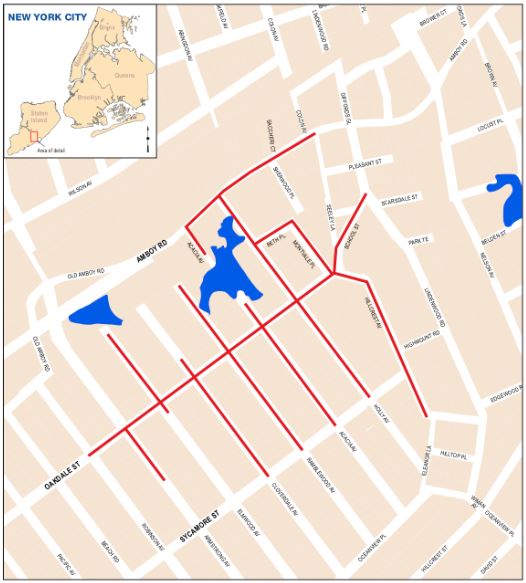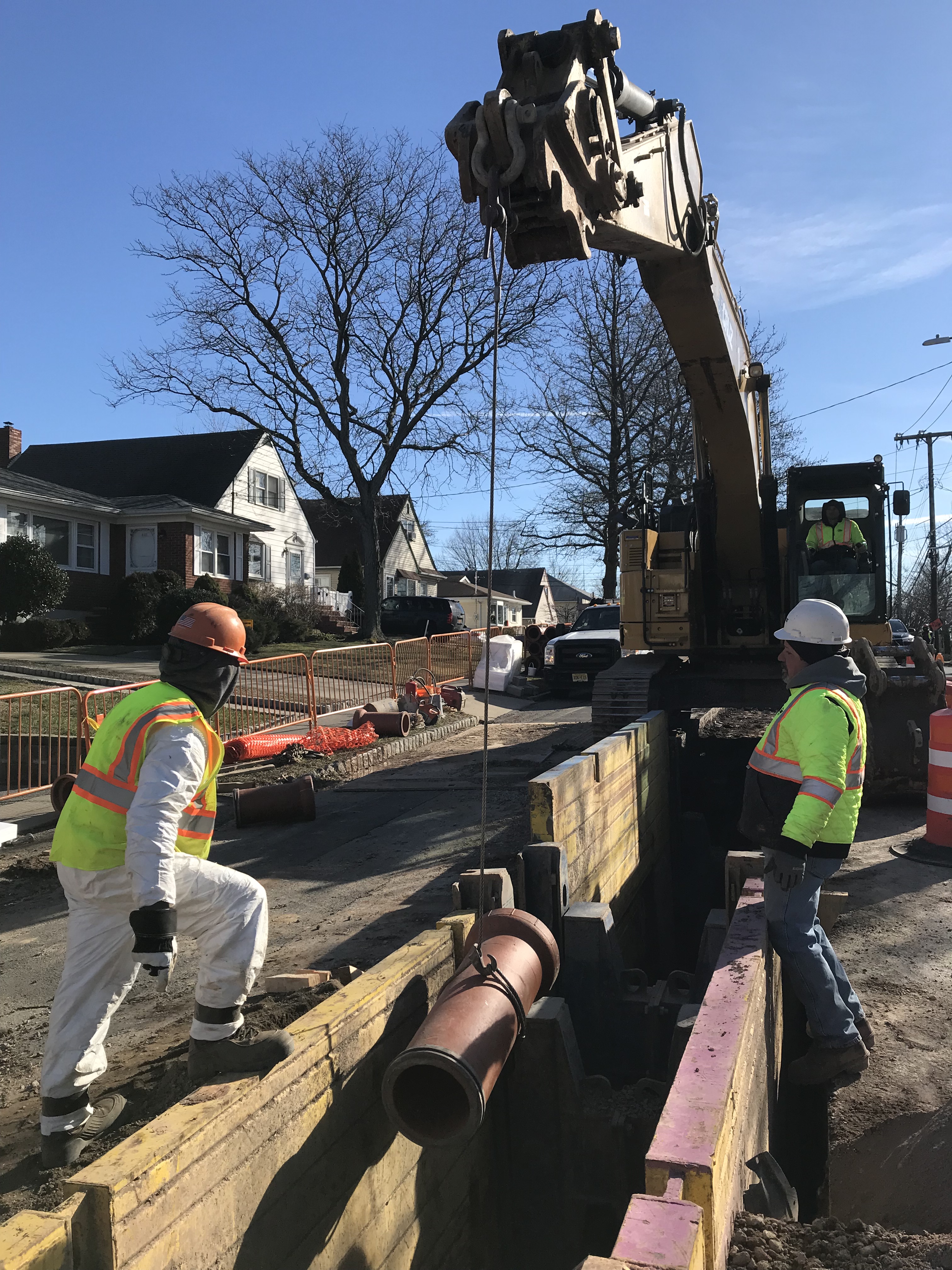
 Department of Design and Construction311
Department of Design and Construction311 Search all NYC.gov websites
Search all NYC.gov websites
$25 Million Infrastructure Upgrade For Eltingville, Staten Island
New Catch Basins and Increased Sewer Capacity will Improve Drainage and Mitigate Flooding
Improvements to Wood Duck Pond Bluebelt Will Help to Protect the Environment
March 7, 2019
DDC: Ian Michaels, 718-391-1589, MichaelsI@ddc.nyc.gov
DEP: 718-595-6600
Staten Island, NY – The New York City Departments of Environmental Protection (DEP) and Design and Construction (DDC) today announced that work is underway to upgrade the drainage and water delivery infrastructure in the Staten Island neighborhood of Eltingville. The $25 million project includes the addition of 100 new catch basins, nearly three miles of new sewers and improvements to the Wood Duck Pond Bluebelt to help reduce flooding and protect the environment. In addition, more than two miles of new water mains and 34 newly added fire hydrants will ensure that residents, businesses and firefighters have ready access to the City’s water supply. DEP is providing the funding for the project while DDC is managing the construction, which is anticipated to be completed in 2020.

“This $25 million investment in Eltingville includes improvements to the Wood Duck Pond Bluebelt that will allow it to better manage stormwater and reduce localized street flooding,” said DEP Commissioner Vincent Sapienza. “I want to thank our partners at DDC for working to preserve the natural beauty of the area while also making much needed infrastructure upgrades that will improve the quality of life in the neighborhood.”
“This project is part of our ongoing partnership with DEP to upgrade infrastructure throughout Staten Island,” said DDC Commissioner Lorraine Grillo. “We have over 20 active sewer projects in the borough and continue to invest to improve quality of life and beautify and preserve natural Bluebelt areas.”
“Protecting Staten Island families and their homes from flooding requires a united effort from all levels of government. Coastal projects like the seawall are the first line of defense, but they also must be combined with flood mitigation projects further inland. I want to thank the New York City Departments of Environmental Protection and Design and Construction for this investment that will give Eltingville residents some more peace of mind,” said Congressman Max Rose.
“This project will not only help to combat the flooding issues that have long plagued the area, but will also aid in the safety of homes with the addition of fire hydrants and the beautification of a more active Wood Duck Pond,” said Council Member Joe Borelli. This is a win for south shore residents and I appreciate DEP’s efforts working with us and the community to make this improvement.”
“This project has offered a much-needed solution to many of Eltingville’s flooding problems,” said Assembly Member Nicole Malliotakis. “It is great to see investment in the Bluebelt, which plays a critical role in our drainage system as well as the ecology of the borough. I look forward to seeing the results when the project is completed.”
As part of the project, more than 6,800 linear feet of stormwater sewers and over 7,400 linear feet of sanitary sewers will be installed along Oakdale Street, between Robinson and Hillcrest Avenues, as well as portions of Amboy Avenue, Armstrong Avenue, Elmwood Avenue, Cloverdale Avenue, Ramblewood Avenue, Holly Avenue, Beth Place, Montvale Place, Seeley Lane, School Street and Hillcrest Avenue.
While the roadway is open to install the sewers, the water mains will also be replaced with 10,600 linear feet of new pipes made of concrete-lined ductile iron, which is more resilient and less prone to breakage than the cast iron pipes typically used decades ago. This will improve water distribution in the area while the 34 new hydrants slated to be installed will ensure firefighters have ready access to the City’s water supply during emergencies. Construction will also include 100 catch basins to help drain stormwater from the roadways.
The plans also call for three natural drainage systems to be built in the vicinity of Wood Duck Pond Bluebelt. Stormwater collected from surrounding roadways will be directed to this Bluebelt wetland, which will be built on City-owned property, to allow the water to be naturally filtered in order to protect the environment. This area is located to the west of the Jack’s Pond Bluebelt, which is currently undergoing a $35 million project to upgrade sewer infrastructure, improve street drainage and enhance the pond’s storage capacity.
For more than 20 years, DEP has built Bluebelts throughout southern Staten Island. In the south Richmond and mid-Island areas, the City has purchased approximately 400 acres to build the Bluebelt systems that support better drainage and wetland preservation with naturalized infrastructure. The Bluebelts also provide important open spaces and serve as a habitat for diverse wildlife. There are over 70 Bluebelts on Staten Island, with additional sites in construction and being planned.
DEP has completed the $25 million Phase I of the mid-Island’s first Bluebelt, New Creek, located in the nearby Midland Beach neighborhood where roadway flooding often occurred during heavy rainstorms. In summer 2017, DEP completed the $15 million construction of a new Bluebelt near Richard Avenue in Pleasant Plains, as well as the $48 million expansion of the Sweet Brook Bluebelt near Sheldon Avenue in Woodrow.

The Department of Design and Construction is the City’s primary capital construction project manager. In supporting Mayor de Blasio’s long-term vision of growth, sustainability, resiliency, equity and healthy living, DDC provides communities with new or renovated public buildings such as such as firehouses, libraries, police precincts, and new or upgraded roads, sewers and water mains in all five boroughs. To manage this $14 billion portfolio, DDC partners with other City agencies, architects and consultants, whose experience bring efficient, innovative and environmentally-conscious design and construction strategies to City projects. For more information, please visit nyc.gov/ddc.
DEP manages New York City’s water supply, providing more than 1 billion gallons of high quality drinking water each day to more than 9.6 million residents, including 8.6 million in New York City. The water is delivered from a watershed that extends more than 125 miles from the city, comprising 19 reservoirs and three controlled lakes. Approximately 7,000 miles of water mains, tunnels and aqueducts bring water to homes and businesses throughout the five boroughs, and 7,500 miles of sewer lines and 96 pump stations take wastewater to 14 in-city treatment plants. DEP has nearly 6,000 employees, including almost 1,000 in the upstate watershed. In addition, DEP has a robust capital program, with a planned $19.4 billion in investments over the next 10 years that will create up to 3,000 construction-related jobs per year. For more information, visit nyc.gov/dep, like us on Facebook or follow us on Twitter.


